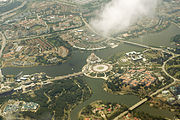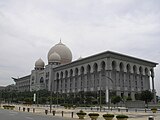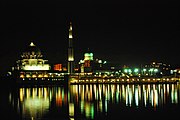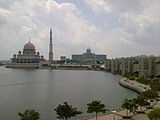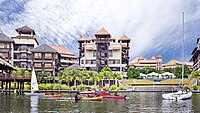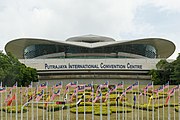|
Putrajaya
Putrajaya (Malay pronunciation: [putraˈdʒaja, putrəˈdʒajə]), officially the Federal Territory of Putrajaya (Malay: Wilayah Persekutuan Putrajaya; Jawi: ولايه ڤرسکوتوان ڤوتراجاي), is the administrative centre of Malaysia.[4] The seat of the federal government of Malaysia was moved in 1999 from Kuala Lumpur to Putrajaya because of overcrowding and congestion,[5] whilst the seat of the judiciary of Malaysia was later moved to Putrajaya in 2003.[6] Kuala Lumpur remains as Malaysia's national capital city per the constitution and is still the seat of the head of state (Yang di-Pertuan Agong) and the national legislature (Parliament of Malaysia), as well as being the country's commercial and financial centre. The establishment of Putrajaya was the idea of Prime Minister Mahathir Mohamad. First thought of in the 1990s, Putrajaya was envisioned to be “a laboratory for a new form of electronic government" that would emphasize new adoption of, investment in internet, media, and digital communications.[7] The development of Putrajaya began in August 1995 and was completed at an estimated cost of US$8.1 billion.[8] On 1 February 2001, Putrajaya became Malaysia's third federal territory, after Kuala Lumpur in 1974 and Labuan in 1984.[8] Putrajaya is also a part of MSC Malaysia, a special economic zone that covers Klang Valley. EtymologyPutrajaya was named after the first Prime Minister of Malaysia, Tunku Abdul Rahman Putra Al-Haj. The name is derived from the Sanskrit language, which was then adopted into Malay; "putra" (पुत्र) means son and "jaya" (जया) means "success" or "victory"; hence Putrajaya means victorious men or people.[9] The name was decided in late 1994.[10] History and design Prang Besar (Jawi: ڤراڠ بسر, alternately Perang Besar (Malay for "Great War"), was founded in 1921 on land that was jungle, as a rubber plantation by British veterans of World War I, hence its name.[11] Its land area of 800 acres (3.2 km2) expanded to 8,000 acres (32 km2), and was merged with surrounding estates, including Estet Raja Alang, Estet Galloway and Estet Bukit Prang. Until 1975, what is today Putrajaya, along with adjacent Cyberjaya, was under the administration of Hulu Langat District. The vision of a new Federal Government Administrative Centre to replace Kuala Lumpur as the administrative capital emerged in the late 1980s, during the tenure of Malaysia's fourth prime minister, Mahathir bin Mohamad. A new city adjacent to Kuala Lumpur was envisioned, where the government would systematically locate its government offices within an efficient administrative hub; as opposed having government offices scattered across the congested Kuala Lumpur.[8] The new city was proposed to be located between Kuala Lumpur and the new Kuala Lumpur International Airport (KLIA). Two areas were proposed: Prang Besar and Janda Baik of Pahang.[12] The new name Putrajaya was chosen for the site. The federal government negotiated with the state of Selangor on the prospect of another federal territory. In the mid-1990s, the federal government paid a substantial amount of money to Selangor for approximately 11,320 acres (45.8 km2) of land in Prang Besar, Selangor. As a result of this land purchase, Selangor now surrounds two federal territories: Kuala Lumpur and Putrajaya.  Planned as a garden city and an intelligent city, 38% of the area is green spaces in which the natural landscape is enhanced.[14] The plan incorporated a network of open spaces and wide boulevards. Construction began in August 1995; it was Malaysia's biggest project and one of Southeast Asia's largest, with an estimated final cost of US$8.1 billion. The entire project was designed and constructed by Malaysian companies, with only 10% imported materials.[14] Most buildings in Putrajaya were built with conscious use of particular Islamic elements from the Middle East and Central Asia like those of Baghdad and Damascus, designed to reflect a cosmopolitan pan-Islamic identity emulating those regions espoused by Mahathir's government, rather than taking from homegrown elements that had took hold in Southeast Asia or those brought from India (like the neo-Mughal buildings of Kuala Lumpur).[15][16] The 1997 Asian financial crisis somewhat slowed the development of Putrajaya. 300 members of the Prime Minister's office staff moved there in 1999, and the remaining government servants moved in 2005. On 1 February 2001, the city was formally transferred to the federal government and declared Malaysia's third federal territory.[17] In 2002, KLIA Transit rail line was opened, linking Putrajaya to KLIA in Sepang. The construction of the Putrajaya Monorail, which was intended to be the city's metro system, was suspended owing to high costs. One of the monorail suspension bridges in Putrajaya remains unused. In April 2013, the Putrajaya government signed a letter of intent (LOI) with the government of Sejong City in South Korea to mark co-operation between the two cities.[18][19] Government and politicsGovernment ministries and bodies remaining in Kuala Lumpur include the Ministry of Investment, Trade and Industry (MITI),[20] Ministry of Defence (MINDEF)[21] and Ministry of Works (KKR), as well as Bank Negara Malaysia, Royal Malaysian Police and Malayan Railways. The Parliament of Malaysia also remained in Kuala Lumpur, as well as the Yang di-Pertuan Agong (King) of Malaysia. Foreign embassies and missions except Brunei still remain in Kuala Lumpur. The local government in Putrajaya is the responsibility of the Putrajaya Corporation (Perbadanan Putrajaya), a unique local authority. Previously it was administered by the Sepang District Council. Putrajaya is represented in the Parliament of Malaysia by one elected MP in the Dewan Rakyat, under the seat of Putrajaya, as well as one appointed senator in the Dewan Negara. As with the other federal territories of Malaysia, Putrajaya does not have a territorial legislature.
DemographicsPopulation
In 2007 the population of Putrajaya was estimated to be over 30,000, which comprised mainly government servants. Government public servants have been encouraged to relocate to the city through various government subsidy and loan programs. The population had increased to 88,300 by 2015.[23] As of Q1 2024, the population of Putrajaya is estimated to be 119,700. ReligionAs of 2020[update], the population of Putrajaya is 97.2% Muslim, 1.1% Hindu, 0.8% Christian, 0.5% Buddhist, 0.4% unknown and 0.1% other religions. InfrastructureGovernment complexes  
Infrastructure and places of worship
MonumentsOpen spaces
Educational institutionsKindergarten and Pre-School
Primary & Secondary Education in Putrajaya is provided by a few schools such as:
There are also two elite fully residential schools in Putrajaya:
Other universities:
International Schools
TransportBy carMajor highwaysPutrajaya is surrounded by federal highways 29 on the western side and 30 on the eastern side. The South Klang Valley Expressway E26, connecting Pulau Indah to Kajang, runs through the northern end of Putrajaya. ELITE E6 exit 607 serves Putrajaya and also nearby Cyberjaya. Highway 29 interchanges with Damansara–Puchong Expressway (LDP) E11 in the northwestern corner of Putrajaya, linking the city with Puchong, Subang Jaya, Kelana Jaya and to Kepong. Within Putrajaya, the following roads serve as the main thoroughfares of the city.
List of road bridges
Public transportRailPutrajaya is served by two urban rail lines: the 7 KLIA Transit line and the 12 Putrajaya Line through the KT3 PY41 Putrajaya Sentral transportation hub on the western border of Putrajaya. The MRT Putrajaya Line is Malaysia's fifth metro line, and the longest in the Rapid Rail network, with Putrajaya Sentral being the southern most station in the network. The KLIA Transit is one of Malaysia's two operational airport rail links, connecting KL Sentral in Kuala Lumpur to its international airport, calling at 3 stations in between including Putrajaya.[26] [27] The national rail network Keretapi Tanah Melayu (KTM) does not serve Putrajaya. The cancelled HSR Kuala Lumpur–Singapore High Speed Rail was meant to serve Putrajaya with a station at Kampung Dato Abu Bakar Baginda, about halfway between Precinct 14 and Bandar Baru Bangi. Around 2003, plans for a monorail in Putrajaya were underway but were halted due to low population. Plans to revive the construction of the 14 Putrajaya Monorail, with proposed connections to Kajang, Bandar Baru Bangi and Cyberjaya, have not yet materialised. BusesPutrajaya Corporation provides its own stage bus services through its subsidiary Nadi Putra using natural gas-powered buses and a few electric buses. The bus service serves the entirety of Putrajaya as well as Cyberjaya and provides express bus routes to Kuala Lumpur through Puduraya and a few other nearby cities from its hubs at Putrajaya Sentral, and P&R Presint 14.[28] Bus stops in Putrajaya are very common too and serves Nadi Putra. Rapid KL, Causeway Link and Cityliner also provides bus services to other areas from Putrajaya Sentral such as Banting, Puchong, Bandar Utama and Petaling Jaya. Intercity buses also serve bus routes from Putrajaya Sentral to the northern states. International relationsTwin towns and sister citiesPutrajaya is twinned with these cities:
ClimatePutrajaya has a tropical rainforest climate (Af) with heavy rainfall year-round and high temperatures throughout the year. As is typical of cities, towns, and other geographical regions with this climate, Putrajaya does not have a true dry season. The average temperature in Putrajaya is 27.1 °C, which is measured at approximately 80.8 °F. Over the course of a yearly period, the rainfall averages 2307 mm in Putrajaya, which is approximately 90.8 inches.[31]
Image gallery
See alsoReferences
Further reading
External linksWikimedia Commons has media related to Putrajaya.
|
||||||||||||||||||||||||||||||||||||||||||||||||||||||||||||||||||||||||||||||||||||||||||||||||||||||||||||||||||||||||||||||||||||||||||||||||||||||||||||||||||||||||||||||||||||||||||||||||||||||













